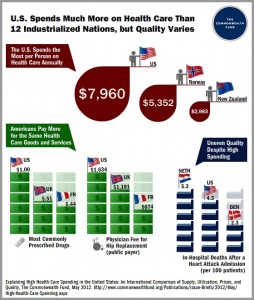The U.S. devotes 17.4% of the national economy to health spending, amounting to about $8,000 per person. The UK devotes about 10%, Germany 11.6%, France, 11.8%, Australia 8.7%, and Japan, 8.5%.
On the physician pay front, primary care doctors in the U.S. earn about $186,000 a year, compared with Australian colleagues who bring in about $92K a year, French peers at $96K per annum, Canadian PCPs earning $125,000, Germans at $131K, and British earning $160K.
When it comes to specialists, like orthopedic surgeons, the pay gap between doctors in the U.S. and colleagues overseas is much greater: on average orthopods earn $442,000 in the U.S. compared to British orthopedists earning $324K per annum, Canadians at $209K, Germans at $202K, Australians with $188K, and French, at $154K.
Hospital prices are also tops in the U.S. Per discharge, Americans spending $18,142; Germans spend $5,072, with an OECD median of $6,222. Thus, the U.S. hospital discharge cost is about 3 times that of other developed countries.
It is no surprise that prescription drug prices in the U.S. are greater than in any other country in the OECD: prices for the 30 most commonly prescribed drugs in 2006-7 were indexed at 1.0 for the U.S. vs. other OECD nations. The overall OECD median was 0.51, with the lowest drug costs seen in New Zealand (o.34 on the index), France (0.44), Australia (0.49), with the next-highest country being Canada at a 0.77 index.
On the technology front, the U.S. has an above-average number of MRIs, CT scanners, PET scanners, and mammographs. Utilization and prices per scan, too, are greater in the U.S. than in other OECD countries. “This combination of pervasive medical technology and high prices showcases two potent drivers of U.S. health spending, and a possible explanation for the outsized share of resources we dedicate to health care relative to the rest of the world,” the Fund states in the report.
The newest aspect of health spending driver is obesity: the U.S. wins the global obesity contest hands-down, with 34% of the U.S. population scoring a BMI over 30. In contrast, the next most-obese nation studied by The Commonwealth Fund was New Zealand, with 26.5% of the population having a BMI over 30; other high scorers on the obesity league table were Australia (24.8%), Canada (24.2%), and the UK (23%). Other countries in the report had fewer than 20% of people with BMI’s over 30. The leanest folks live in Switzerland and Japan, according to the latest OECD health database.
Health Populi’s Hot Points: With all that health spending, health outcomes in the U.S. don’t uniformly rank at the top of the OECD roster. The U.S. ranks higher for breast cancer and colorectal cancer survival (along with Norway). However, the U.S. ranks lower than median OECD for cervical cancer. The U.S. also has higher than average rates for conditions amenable to treatment (which I wrote about here in Health Populi) such as asthma, diabetes (measured by lower-extremity amputations per 100,000 people) and cardiac disease.
The Commonwealth Fund calculates that if the U.S. spent the same rate on health care as in Japan, the U.S. would save $1.25 trillion a year — more than the U.S. defense budget. The Fund notes that Japan has a fee-for-service system with no restrictions on specialists and hospital choice. The country also boasts advanced medical technology. What they do in Japan is regulate health prices.
Ultimately, higher prices for health services do what prices in other markets do: crowd out people who can’t afford services to seek substitutes. In health care, that’s not so easy to do, beyond seeking over-the-counter therapies from pharmacies as alternates for prescription drugs, and other self-help remedies. Many people turn to the internet for advice and crowdsourcing of health solutions. More of us are quantifying ourselves with the objective of staying healthy and trying to avoid entering the health system.
Ultimately, though, every health citizen needs a physician – a medical home – and as we age, a hospital bed, at some point, to deal with the growing burden of chronic conditions that inevitably hits every human. The market itself doesn’t sort this out on its own.





 Thank you FeedSpot for
Thank you FeedSpot for